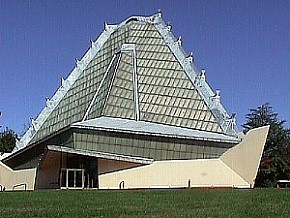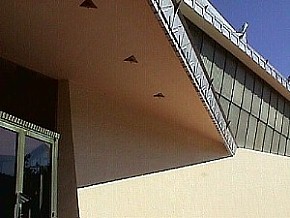2009.08.16 18:06
Postmodernism sucks... discuss
Of course architecture and film evolve for the most part independently, as I already referenced Scully and Kahn above.
The relation between film and postmodern architecture I'm here discussing is not one where the architecture emulates the films, rather architects took on the 'realist' frame of mind of 60s and 70s films, again where there are no clear rules beyond the immediate context of the situation.
Architecture today is still very eclectic, diverse even, and, perhaps more now that ever, there are no clear rules beyond the immediate context of the situation.
2009.08.16 12:42
hence creative ingenuity
creative: the vast majority of more recent residential architecture.
ingenutiy: the more recent residential projects of Koolhaas/OMA.
2009.08.18 12:50
Postmodernism sucks... discuss
Does 'ad grand mosque' operate within a realm of no clear rules beyond the immediate context of the situation?
Religious architecture, almost by definition, operates within a realm where there are clear rules beyond the immediate context of the situation.
I'm reminded of Frank Lloyd Wright's Beth Sholom Synagogue (1954),


where there are clear uses of ornament, albeit a modern building.
Symbolism, too, continues to be an (almost innate) ingredient of religious architecture.

St. Helena Church, Olney, Philadelphia (1950).
According to legend, St. Helena, feast day 18 August, discovered the 'True Cross'.
| |
2009.08.18 15:40
Postmodernism sucks... discuss
...it is interesting that a legal prohibition of official prayer within Hagia Sophia was deemed necessary, but I'm not sure what that has to do with architectural design and how architects design.
Or are you providing an example of religious architecture operating within a realm where there are clear rules beyond the immediate context of the situation, even when the rules are clearly anti-religious?
2009.09.01 17:53
fashion tip (of the iceberg)
arbitration and arbitrariness blurred
reality being relative to the vastness of its container
arbitration and arbitrariness come into focus as instinct
realms juxtaposed
"the time it takes to do this" as continuum
i.e., "...to compose this novel in a real/virtual manner. Do you assume this intention needs support from the living?"
background music: ...sounds a blur (in a good way) between Saussure and the debunked Blavatsky, but to no surprise as I have heard the two in the same breathe before.
2009.09.03 12:00
Palais Imperial de Dolma Baghtche
[The account of Hamann's subsequent relationship with Kant, where the latter was engaged by Hamman's quondam employer in Riga to bring the reborn religious enthusiast back to the path of reason, is the stuff of the very best historical novels.]
As if by divine chance, the next chapter (this morning) is entitled: Spectacles and Eyes to See With: Two cultures in philosophy. Operations within a surgical double theater, indeed.
malpractice case Cambridge 1992
the Derrida affair
They [Ayrs and Bataille] met in a Parisian bar in 1951, with Merleau-Ponty.
who are they?

and was it on purpose that their mirror image is what appears in this chapter?
then again, upon reflection
"I believe in spectacles, but I think eyes are necessary too."
no C.P. Snow daze. know sleepy snow days.
finally Cosmopolis.
| |
2009.09.03 13:11
fashion tip (of the iceberg)
It was the "post-mortem discourse" that rekindled the vertigo of the mélange. The thought was post-modernism as still life.
But the strange fascination of still life, isn't it also a fiction? Or indeed an ethereal necrophilia?
--The Man without Qualities
The only gesture possible would seem to be stillness, what "in painting is called Stilleben (still life), or in other languages... natura morta (dead nature)."
--ibid
Life is magically arrested in its impermanence: "objects, animals, plants, landscapes and human bodies frozen into stillness by the magic of art," in a sort of "demonical" mystery.
--ibid
The world itseld seems to be suspended in an unending instant, in a landscape like the "sixth day of Creation, when God and the world were still alone, without men"
--ibid
"It is extraordinarily simple, but also very odd," says Ulrich.
"We have found many contrived answers," says Ulrich, "but we have overlooked th simplest: that both may have the intention and the capacity to take everything of which they have experience only as Gleichnis" And "every Gleichnis is ambivalent for the intellect, but for the feeling it is univocal;" and therefore it should be possible to experience "as oneness that which be common estimate is twofold."
"In that instant there occurred to Ulrich the idea of a state of life in which the being here was Gleichnis of the being there, and the impossible experience of being a person with two distinct bodies might lose the thorn of its impossibility."
Gleichnis is never Gleichheit.
--overall Franco Rella
He found Renfrew in a hectic mood, as close to desperation as Lew could recall.
... Lew had the sudden certitude that right now in Göttingen some bilocational Lew was asking Werfner the same question...]
--mirror::rorrim
"magnigicent chaos of the museum"
2009.09.04 10:29
Process is more important than product
"Does our obsession with process and problem solving exist because we would rather establish a clear and repeatable working method than continually face the proverbial blank sheet of paper? Does it exist because process is easier and quicker to teach than precedent? Or because discussing the processes of "research architecture" in design gives us something to talk about in reviews, or something convincing to say to clients? Is it so that, as with Abstract Expressionism, we can forgo painterly dexterity in favor of the will to discover? Have we, in fact, ordained process, research, and analysis as some architectural version of the Jonas Brothers--an unchallenged design anthem to be broadcast on all channels at all times and for any reason--in order to avoid confronting a line that lacks a legitimate rationale?"
--Mark Foster Gaga, "In Defense of Design" in Log 16 (Spring/ Summer 2009).
| |
2009.09.04 15:06
Process is more important than product
Just for clarity's sake, care to provided examples of site-sensitive form-making.
The gist of Gage's essay overall speaks of precedence and intuition as a seemingly forgotten or overlooked part of the design process. What Gage's essay does not have is any illustration of what precedence and intuition within the design process might produce. Judging his firm's work in light of the essay may indeed be (further) revealing.
2009.09.18 16:54
Your Ideal City mash up....
Neuschwanstein + Las Vegas + Atlantic City + an Indian Reservation + Monte Carlo + Dubai + Angkor Wat + Pompei = "My kind of town."
2009.09.19 10:38
Rem: use minimum items to understand its project
Study any of the more recent Koolhaas/OMA residential projects* and you will quickly find that you cannot "use two drawings and one sentence to understand" the work.
*
Bordeaux House
Y2K
Wenner House
Flick House I
Flick House II
Ascot Residence
Sighvatsson House
Vincent Gallo Apartment
Also look at Prada San Francisco Epicenter and Whitney Museum Extension.
2009.09.27 14:38
Who are the URMs in architecture grad school?
So, maybe, if architecture school wasn't such a pretend thing, the minority would excell and the majority would fail?
2009.09.30 21:33
Information Architects Talking About Architects and Architecture
Presently, I like to design delivery of content in the enfilade slash labyrinth style.
Perhaps, someday, I'll design some delivery of content following the architecturale promenade formula.
Actually, I've been struggling with a big design/renovation brief, the solution to which has been eluding me for well over a month now. Alas, today, while just stepping out of the shower, it finally dawned on me--delivery of content in the enfilade slash labyrinth style via bilocation.
Is subtext actually text bilocated?
2009.10.02 14:46
Information Architects Talking About Architects and Architecture
Does that perhaps mean that architects have an aversion to being cognitively challenged by virtual worlds?
| |
2009.10.23 15:10
Really, what boundaries have you pushed?
Is the rollercoaster a boundary? Or is riding the rollercoaster an experience of pushing boundaries?
food for thought:
"Writing in a language never fully his own, Kafka pushes that language further and further in the direction of his own deterritorialization, to the point where it shakes free all literariness, taking on a concrete but strange--surreal? hyperreal?--materiality. Deleuze and Guattari actually characterize Kafka's mode of writing as a "new sobriety." They contrast the rigorous strangeness of his form of literary enunciation with the esoteric and kabbalistic mysticism of Max Brod, his friend and fellow Czech-Jewish writer, the latter attempting to effect a symbolic reterritorialization by artificially enriching the appropriated German language with arcane signifiers. Likewise, citing the parallel instance of two Irish writers, James Joyce and Samuel Beckett, Deleuze and Guattari compare Joyce's excessive, polyglot Irish-English with Beckett's parsimonious English and French: "The former never stops operating by exhilaration and overdetermination and brings about all sorts of worldwide reterritorializations. The other proceeds by dryness and sobriety, a willed poverty, pushing deterritorialization to such an extreme that nothing remains but intensities."
--Ockman
"We happen to be fundamentally interested in challenging and advancing typologies. So from day one we were much more interested in "OK, this has to be a flexible theater. What does that mean? How do we do that? How do we make that happen."
--Prince-Ramus
2009.10.25 10:11
Really, what boundaries have you pushed?
Might we then conclude that pushing boundaries is uncommon, and muddling-through, (drunken) rage, and even pretense are common?
Does pushing boundaries at least require a metabolic (destructive / creative, challenging / advancing) imagination?
2009.10.25 11:30
Really, what boundaries have you pushed?
Might we then conclude that passive is common, and active is uncommon?
2009.11.16 09:55
The current state of Architecture Theory
"The ability of the computer to locate every point on a carved surface does away with the need for rational comprehension on the part of the designer in conceiving, or the observer in perceiving, a building. Thanks to the computer, pure empiricism has no longer any practical need for the mediating grasp of the intellect. The maximum of an empirical nominalism coexists with the maximum of abstraction. The space between nominalism and abstraction is left void. The mind no longer needs to understand itself. After a long evolutionary detour, human thought returns to its primitive instinctual roots."
Colquhoun (2005)
"...I was entranced by the work of James Gamble Rogers, the architect who designed most of Yale's Gothic and Georgian architecture in the 1920s and 1930s. Roger's determinedly nonideological stance, his avoidance of theory in favor of what can only be called intuitive design, was liberating. It was alright for architecture to be about feeling good, I suddenly realized; stage sets were not immoral. It was the perfect epiphany for a twenty-year-old who was just beginning to learn about empirical experience and only starting to trust his eye."
Goldberger (2009)
|